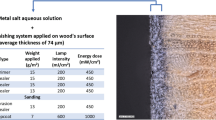Abstract
Introduction
In the Middle Ages, we could find gildings on mural paintings. Gold, silver or tin leaves were applied according to distemper or mixtion technique. For the first one, a binder as glue is necessary, and for the second, a lipidic binder is used to stick the metallic leaf. Studies of gildings materials characterization show that the mixtion technique, with a mordant, is the most common. Linseed oil seems to be the binder used. It is always mixed with a siccative agent as lead. Because of bad conditions of conservation, the gildings do not resist anymore, only remain traces of metal or the adhesive under-layer. Thanks to the binder fluorescence, we can nowadays detect ancient gildings.
Objective
The purpose of this paper is to study the degradation of the linseed oil, generally mixed with lead white to give a mordant for the metallic leaf, by spectrofluorimetry.
Materials and methods
To understand in situ fluorescence, gildings recreations, linseed oil and lead white are aged in hygro-thermal and ultraviolet (UV) light (313 nm) climatic rooms and under UV irradiation. Irradiation wavelengths are chosen according to the maximum of absorption of linseed oil and the bibliography (296, 313 and 366 nm = mercury bands).
Results
In comparison with results (in situ UV lamp, spectrofluorimetry), excitation wavelength chosen is 366 nm. Irradiations at 366 nm of linseed oil and linseed oil mixed with lead white show the most degrading effect in the fluorescence to the big wavelength. Lead white plays an important siccative role; it increases the intensity fluorescence and accelerates the drying of linseed oil. This study also allows to show that 366 nm wavelength is good for the in situ observation.











Similar content being viewed by others
Notes
Samples were irradiated in a black room at ambient temperature (25°C to 29°C) and a relative humidity of 20 %; the temperature, measured with a thermocouple on the sample, was 26°C to 29°C.
References
Aze S (2005) Altérations chromatiques des pigments au plomb dans les œuvres du patrimoine, thèse de doctorat de l’Université d’Aix Marseille, 210 pages
Cennini C, XIVe, réédité en (1991) Il libro dell’arte, Berger-Levrault, Paris, p.188-313
Czerniak V, Stouffs J-M, Tessariol M, Daniel F (2007) Le décor peint et la polychromie du portail occidental de la cathédrale Saint-Étienne de Cahors. Tome LXVII, Mémoires de la Société Archéologique du Midi de la France, pp 97–112
Daniel F, Mounier A (2010) Alteration of gildings on mediaeval mural paintings, Réunion intermédiaire de l’ICOM CC “Multidisciplinary conservation, a holistic view for historic interiors” http://www.icom-cc.org/54/document/alteration-of-gildings-on-mediaeval-mural-paintings/?id=797. Accessed 23–26 Mar 2010
De la Rie ER (1982a) Fluorescence of paint and varnish layers (part I). Stud Conserv 27:1–7
De la Rie ER (1982b) Fluorescence of paint and varnish layers (part II). Stud Conserv 27:65–69
De la Rie ER (1982c) Fluorescence of paint and varnish layers (part III). Stud Conserv 27:102–108
Karoui R, Kemps B, Bamelis F, De Ketelaere B, Merten K, Schoonheydt R, Decuypere E, De Baerdemaeker J (2006) Development of a rapid method based on front-face fluorescence spectroscopy for the monitoring of egg freshness: 1-evolution of thick and thin egg albumens. Eur Food Res Technol 223:303–312
Larson L, Shin K, Zink J (1991) Photoluminescence spectroscopy of natural resins and organic binding media of paintings. J Am Inst Conserv 30(1):89–104
Lazzari M, Chiantore O (1999) Drying and oxidative degradation of linseed oil. Polym Degrad Stab 65:303–313
Mallégol J, Lemaire J, Gardette J-L (2001a) Yellowing of oil-based paints. Stud Conserv 46(2):121–131
Mallégol J, Gonon L, Lemaire J, Gardette J-L (2001b) Long-term behaviour of oil-based varnishes and paints. 4. Influence of film thickness on the photooxidation. Polym Degrad Stab 72:191–197
Masschelein-Kleiner L (1992) Liants, vernis et adhésifs anciens. Bruxelles, Institut Royal du Patrimoine Artistique, 3e éd. 123 p
Matteini P, Camaiti M, Agati G, Baldo MA, Muto S, Matteini M (2009) Discrimination of paintings binders subjected to photo-ageing by using microspectrofluorometry coupled with deconvolution analysis. J Cult Herit 10:198–205
Mounier A, Daniel F, Bechtel F (2010a) Gilding techniques in mural paintings: three examples in the Romanesque period in France. Proceedings of the 37th International Symposium of Archaeometry “Archeometry 2008”, Siena, 12–16 May 2008 (in press)
Mounier A, Dayet L, Belin C, Daniel F (2010b) Etude de la fluorescence des liants employés dans les dorures sur peintures murales médiévales, Archéosciences–Revue d’archéométrie (in press)
Mounier A, Daniel F, Bechtel F (2010c) L’illusion de l’or–Imitation de dorures dans les peintures murales médiévales. Archéosciences–Revue d’archéométrie (in press)
Pastoureau M (1999) Le temps mis en couleurs: des couleurs liturgiques aux modes vestimentaires (XIIe–XIIIe siècles), Bibliothèque de l’école des Chartres, Vol. 157, N1, p.111-135
Stenberg C, Svensson M, Johansson M (2005) A study of the drying of linseed oils with different fatty acid patterns using FTIR-spectroscopy and chemiluminescence (CL). Ind Crops Prod 21:263–272
Théophile (Moine), XIIe s., réédité en (1996) Essais sur divers arts, publié par le Cte Charles de l’Escalopier, réédition Laget, Nogent Le Roi, pp 39–44
Thoury M (2006) Identification non-destructive des vernis des œuvres d’art par fluorescence UV. Thèse de doctorat, Université Pierre et Marie Curie Paris VI
Author information
Authors and Affiliations
Corresponding author
Additional information
Responsible editor: Philippe Garrigues
Rights and permissions
About this article
Cite this article
Mounier, A., Belin, C. & Daniel, F. Spectrofluorimetric study of the ageing of mixtions used in the gildings of mediaeval wall paintings. Environ Sci Pollut Res 18, 772–782 (2011). https://doi.org/10.1007/s11356-010-0429-5
Published:
Issue Date:
DOI: https://doi.org/10.1007/s11356-010-0429-5




